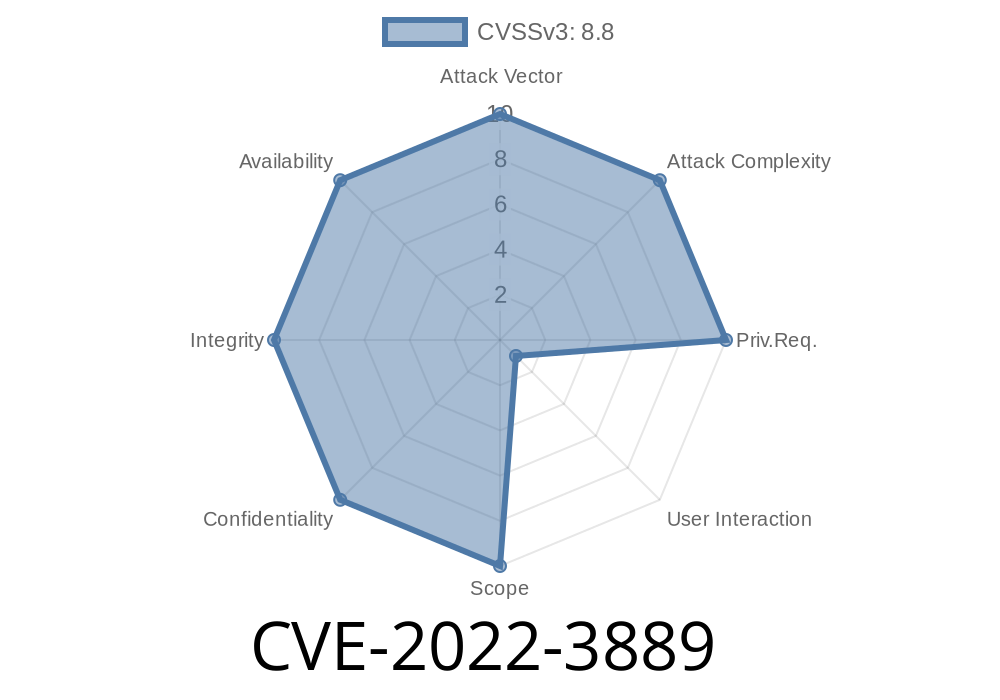In the ever-evolving world of cyber security, new vulnerabilities are being discovered and patched almost on a daily basis. One such vulnerability that has recently come to light is the type confusion bug in the V8 JavaScript engine of Google Chrome. This vulnerability - CVE-2022-3889 - allowed remote attackers to potentially exploit heap corruption via a crafted HTML page. Before we dive into the details of the bug, let's first understand what type confusion is and what makes it a dangerous security flaw.
What is Type Confusion?
Type confusion, also known as type mismatch or type casting, occurs when a programming language or a piece of code mistakenly handles one data type as if it were another. This can lead to several issues like crashing, resource leakage, or in some cases, even malicious code execution, thus compromising the security of the application.
Details of CVE-2022-3889: Chrome V8 Engine Vulnerability
The CVE-2022-3889 vulnerability was present in Google Chrome before version 107..5304.106, with the official Chromium project acknowledging its severity as "High". As previously mentioned, this vulnerability stems from Google Chrome's V8 JavaScript engine, which is responsible for processing and running JavaScript code in webpages. The vulnerability could be exploited by a remote attacker through a specifically crafted HTML page, leading to potential heap corruption and ultimately, remote code execution (RCE).
The discovery of the vulnerability led to the release of a patch with Chrome version 107..5304.106, offering a fix for the type confusion bug in V8.
Code Snippet Demonstrating Vulnerability
It is important to note that sharing a complete exploit proof-of-concept (PoC) for an unpatched vulnerability would be highly unethical and dangerous. However, for educational purposes, let's consider the following hypothetical code snippet that demonstrates a type confusion scenario:
// Hypothetical Code Snippet demonstrating type confusion
// NOTE: This does NOT represent the actual vulnerability in Chrome's V8 engine
function confusedFunc(input) {
let str = 'This is a string';
let num = 42;
if (input) {
str = num;
}
// This function assumes that its argument is a string and takes its length
return calculateStringLength(str);
}
function calculateStringLength(s) {
return s.length;
}
console.log(confusedFunc(true)); // TypeError: Cannot read property 'length' of undefined
In this hypothetical example, the confusedFunc() function suffers from type confusion due to the faulty assignment of the num variable (a number) to the str variable (originally a string). Consequently, this leads to a TypeError when the calculateStringLength() function attempts to extract the length of a number, which is undefined.
How to Protect Yourself from CVE-2022-3889
To safeguard against this vulnerability, users should promptly update Google Chrome to the latest version (107..5304.106 or later) that includes the official patch for the type confusion issue. Ensuring that automatic updates are enabled for Chrome will further help users in staying protected from any future vulnerabilities.
Links to Original References
- Chromium Git Log
- Google Chrome Releases Blog
Conclusion
In conclusion, the CVE-2022-3889 vulnerability showcases the importance of staying up-to-date with security patches and being vigilant about potential attack avenues. As cyber threats continue to evolve, it is essential for developers and users alike to keep abreast of new vulnerabilities, secure coding practices, and relevant security updates, limiting the opportunities for attackers to exploit weaknesses in the software ecosystem.
Timeline
Published on: 11/09/2022 04:15:00 UTC
Last modified on: 11/14/2022 15:15:00 UTC
